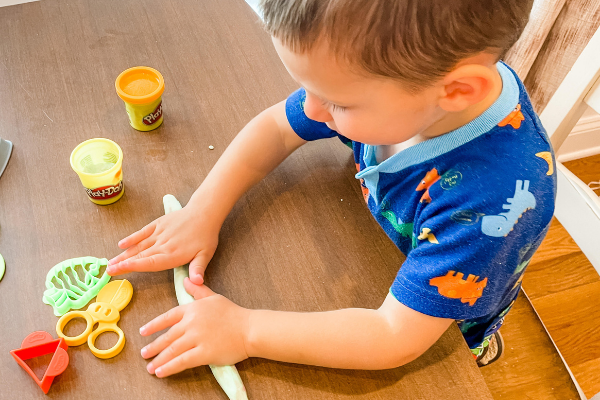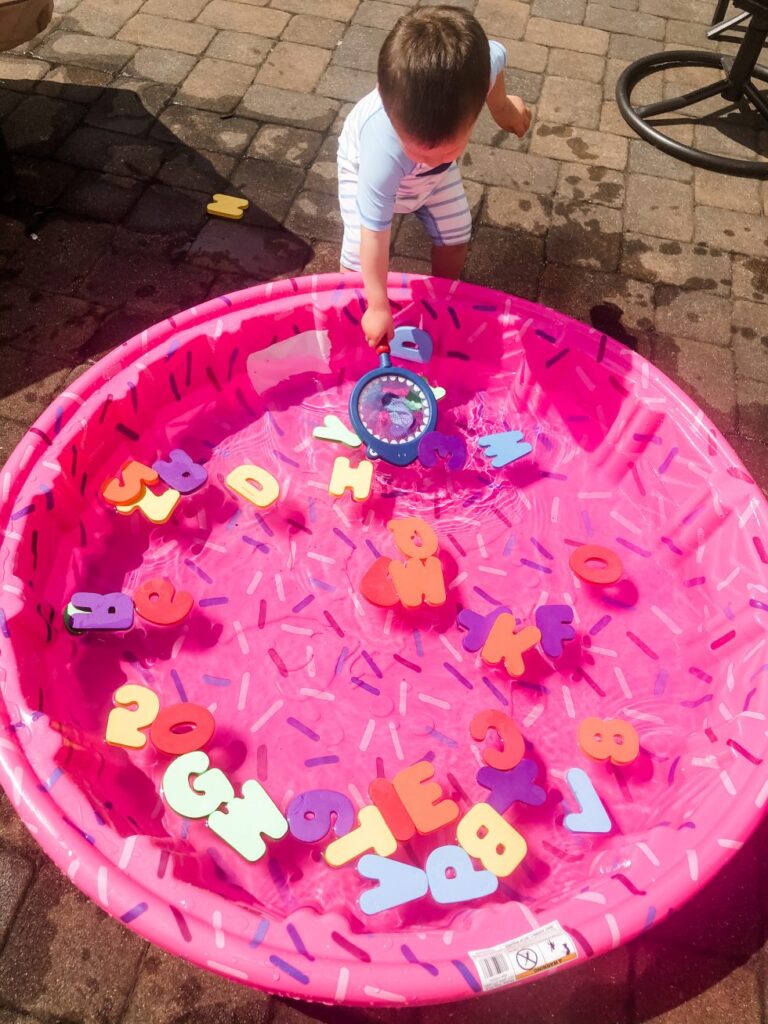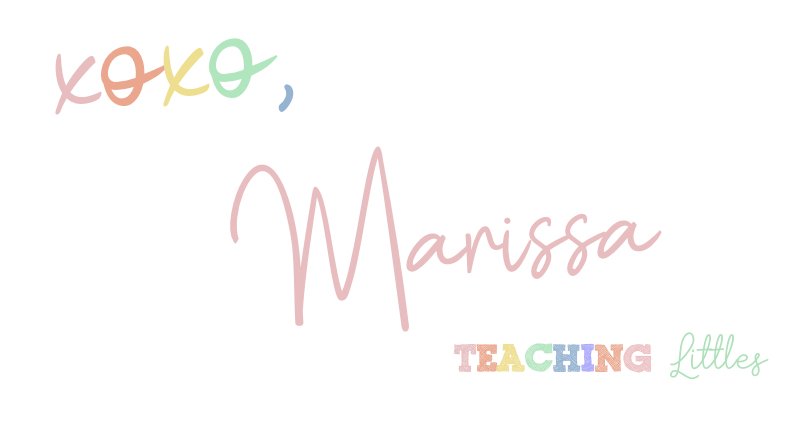Learning letters is one of the key goals kids work on throughout preschool and kindergarten. At this age, you want to teach letter recognition as a precursor to reading, which typically begins between kindergarten and 1st grade.
Understanding that letters make sounds and phonemic awareness is the most crucial part of reading, but letter recognition matters as well. Kids should continue to build their fluency and comfort with all the letters of the alphabet.
There are plenty of ways to teach letter recognition. You may want to use a letter per week approach or a “boot camp” style of teaching, introducing a letter per day.
The truth is that there is no right or wrong way to go about this. What matters the most is your child making progress AND enjoying their time. We never want to make learning anything other than fun; it’s essential to always instill a love of learning from an early age!
Related: 17 Best Toys for Learning Letters: Early Learning Toys
What is Letter Recognition?

Letter recognition involves learning each letter of the alphabet based on its shape and the sounds it makes. Children start by identifying letters through the shapes, visually recognizing them. Your child should be able to point to a letter and say it’s name.
Later, he will learn the sounds of each letter as he investigates phonemic awareness and phonics.
Children also learn how to form and write letters. Mastering a pencil takes time, but kids can learn how to form letters with materials like Play-Doh.
All of these skills develop over time, and the first one you should focus on is recognizing letters by sight. Children must learn to visually recognize the letters.
When Should a Child Recognize Letters of the Alphabet?
The age when a child learns the alphabet varies widely, just like kids all walk and talk at different ages.
In general, kids start to learn letters between the ages of three and four years old. They need to know their letters to start 1st grade, which is between five and six years old.
Related: How to Teach Toddler to Read: Building Early Reading Skills
What Order to Introduce Alphabet Letters
Many teachers don’t introduce letters in alphabetical order, which may be what you assume is the easiest. There are plenty of orders; no one way is the right way.
Here is a common letter order for preschool.
- S ,A, T, I, P, N
- C, K, E, H, R
- M, D, G, O
- J, Z, W
- V, Y, X
However, this is just one order to follow.
No matter the order you pick, it’s best to work with one set of letter before moving to the next set. Work on a range of activities like teaching their sounds, shapes, and names.
Once mastering the row, it’s safe to move to the next row.
Is It Better to Teach Uppercase or Lowercase Letters First?

You may wonder if you should introduce uppercase or lowercase letters first.
Many occupational therapists recommend starting with capital letters for handwriting development because they have larger lines and curves the don’t change directions.
Children take time to develop their visual-motor skills, and it’s easy to develop poor writing habits. That’s one of the reasons uppercase letters are recommended first.
How Do I Teach My Child Letter Recognition?

There are various ways to help your child recognize letters. Early reading skills all start at a young age as you read and talk to your child.
Kids have to learn and take in language through their ears before they can recognize letters with their eyes. So, before your child starts to read or recognize letters, work on these.
- Reading
- Enjoying poems and nursery rhymes together
- Talking
- Telling stories to your child
- Sing songs
Reading and letters should be a regular part of your day. When you read, run your fingers under the word. Let your child turn the pages, and make sure you always have books available in your home
12 Ways to Teach Letter Recognition
1. Play Go Fish with Letter Cards

One of my favorite ways to teach letter recognition is to play go fish with letters. You can match uppercase to uppercase, lowercase to lowercase, or uppercase to lowercase.
Playing Go Fish is a great way to keep your preschoolers and kindergarteners to practice recognition. It’s best to start with a small pile of letters your child does know and a few he isn’t confident with yet.
Over time, you can add more letter cards to the pile.
2. Play-Doh Letters

Play-Doh is a huge hit for little kids, fulfilling sensory seeking needs.
A great way to work on identifying letters is by making play-doh letters on mats. Kids roll out the play dough like a snake and make the shape of the letters. It’s best to do this on laminated mats so you can reuse them repeatedly.
Related: Teach Scissor Skills by Cutting Play-Doh
3. Hunt for Letters
Another interactive way to work on recognizing letters is to hunt for the letters.
Print out letter cards and hide them around your house or classroom. Put the control cards in a basket and the child draws a card. Then, he has to hunt for the other letter that is hid somewhere in the room.
Another way to play this is to give your child the control card, and they have to hunt for the letter anywhere, such as on book covers, signs on the wall, posters, etc.
4. Find Letters in Sensory Bins
Grab some magnetic letters and create a sensory bin. Try filling it with rice, beans, kinetic sand, or whatever you want.
Then, bury the letters in the material and give your preschooler trucks, spoons, or whatever you want. Once they find a letter, they have to tell you what it is. They’ll love this activity!
Related: 7 Benefits of Sensory Bins and How They Support Child Development
5. Jump on The Letters
Grab some painter’s tape and create letters on your hardwood or tile floor. Painter’s tape won’t leave any marks; it’s easy to pull up.
Call out a letter and have your child jump on the letters as you call them out. Focus on letters your child knows and add a few that he doesn’t know with certainty.
6. Write Letters in Shaving Cream

I bet you remember writing letters in shaving cream! We all did it in school; it’s something kids love!
Put some shaving cream on the table or desk and call out letters for your child to write. You can write them on the board or a dry erase marker for your child to copy as well.
Related: Shaving Cream Writing: A Fun Learning Activity
7. Sort Letters on Alphabet Mats
A simple idea is to work on sorting letters based on their attributes.
Grab some letter stamps or magnets, and they can group them by vowels or consonants. Look at the shapes of the letter; put curvy letters in one side with straight line letters in another pile.
Have fun with it!
8. Make Letter Crafts
You’ll find an abundance of letter craft ideas on Pinterest! Try to make some letter crafts, but don’t do them all the time. Kids burn out of crafts easily, and so will you!
9. Read Alphabet Books

One of the best ways to work on letter recognition is by reading books, especially alphabet books that focus on the letters.
Have your child look for letters in the book while you read and pause to discuss as you go through.
10. Write and Wipe
An easy way to practice letters with your child is to give them a small whiteboard and dry erase marker. Call out a letter and have your child write it on their board and hold it up to you.
You also can use white boards for tracing letters and practicing spelling!
Related: Teaching Letters on a Dry Erase Board
11. Build Letters
There are so many materials you can use to build letters to reinforce letter recognition.
Grab some cotton swabs and build letters – these even can be bent to make the curvy parts of some letters. Use popsicle sticks or sticks from outside.
You can find all sorts of materials! Here are some ideas.
- Cereal
- Pennies
- Buttons
- Dried Beans
- Mini-Marshmallows
- Yarn
- Rice
12. Go Fishing for Letters

You can purchase a magnetic letter fishing game or make your own fishing for letters game.
I put foam letters into a baby pool and let your child scoop out the letters. You can call out a letter and have your child find it. Another option is to have your child fish for uppercase and lowercase letters, looking for matching pairs.
Related: Fishing For Letters Toddler Outdoor Activity
Working on letter recognition is part of preschool and kindergarten. It doesn’t have to be boring; this can be a fun part of learning for young kids. Try these ideas!

